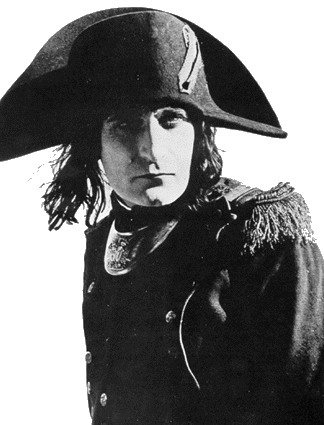
WILL THERE BE LIGHT TOMORROW?
The History of the Greatest Conspiracy
Man Has Ever Known
Part I:
The Conspiracy

WILL THERE BE LIGHT TOMORROW?
The History of the Greatest Conspiracy
Man Has Ever Known
Part I:
The Conspiracy
Fera-t-il jour demain?
Will there be light tomorrow?
For those who are in the know, this seemingly banal question is, in fact, the scariest thing of all -- a heralding
sign of terror and murder most foul... For these simple words are the password of the criminal comspiracy known
as the "Habits Noirs"
in France, the "Black Coats"
in England, and many other names, which exerted its nefarious influence over Europe during most of the 19th century.
In fact, this Conspiracy is, as we will discover, at the very root of the Wold Newton universe, and had far reaching
consequences, heretofore entirely unsuspected.
The story of this Conspirecy, however, has its roots in a far distant past...
1. Assassins and Templars
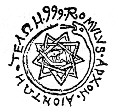 Even
in modern times, scholars of popular fiction are familiar with the notorious Order
of the Assassins of Alamut, a medieval islamic sect, ruled by the legendary
Old Man of the Mountain. The word "assassins" is usually linked to hashish, and the name of the group
is sometimes spelled "Hashishins,"
because of their alleged use of the drug to keep their fearsome warriors properly motivated. Much later, the man
calling himself Count of Monte-Cristo made use of hashish in the same fashion, and recounted a popular version of the Assassins'
history.
Even
in modern times, scholars of popular fiction are familiar with the notorious Order
of the Assassins of Alamut, a medieval islamic sect, ruled by the legendary
Old Man of the Mountain. The word "assassins" is usually linked to hashish, and the name of the group
is sometimes spelled "Hashishins,"
because of their alleged use of the drug to keep their fearsome warriors properly motivated. Much later, the man
calling himself Count of Monte-Cristo made use of hashish in the same fashion, and recounted a popular version of the Assassins'
history.
What is not as widely known is that, in fact, the name "Assassins" derives from the word "Assass,"
meaning "Guardians" or "Protectors", for the Assassins were in reality the Islamic Soldier-Monks
in charge of the protection of the Holy Land. "Assasseen in Arabic signifies
'guardians', and some commentators have considered this to be the true origin of the word: 'guardians of the secrets'." - Arkon Daraul, Secret Societies.
The Assassins were the keepers of much occult knowledge, inherited from Israel, Babylon, Egypt, and other far more
ancient sources. They knew the secrets of the gnostic and of the kabbala. Their role in the history of alchemy
is well documented. The longer-than-normal lifespan of their leader, Hasan ben Saba, the Old Man of the Mountain,
is one clue; another is their motto, the alchemical saying, Nothing is true...
Interestingly, in Les Habits Noirs, Paul Féval revealed that the word "Nothing," translated in 30 languages, carved on two ivory disks, was the ultimate secret locked
inside the "Scapulaire de la Merci" (Scapulary of Mercy), a pendant worn at all times by Colonel Bozzo-Corona, the fearsome leader of the gang. But
let's not anticipate...
In 1099, the Crusaders captured Jerusalem. In the ensuing years, many contacts took place between the Christian
Knights and their Islamic counterparts. In 1118, under the leadership of Hugues de Payen and Hugues de Champagne,
nine knights were authorized to form a new order to guard and protect Mount Moriah, upon which once stood the Temple
of Solomon. These nine called themselves -- Templars.
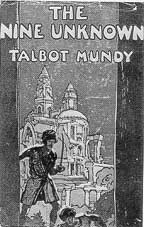 The
concept of Nine Old Men, The Nine Unknown,
is nothing new. It existed in India before Islam and Christianity, and even the notorious adventurer James Schuyler
Grimm, better known as Jim Grim, whose exploits were chronicled by Talbot Mundy, could not reach the fabled Nine.
Closer to us, Philip Jose Farmer disguised the truth of the Nine, and their use of various historical heroic figures
throughout history, in a fanciful, fictional trilogy, A Feast Unknown, Lord of the Trees
and The Mad Goblin. But again, we are
getting ahead of ourselves...
The
concept of Nine Old Men, The Nine Unknown,
is nothing new. It existed in India before Islam and Christianity, and even the notorious adventurer James Schuyler
Grimm, better known as Jim Grim, whose exploits were chronicled by Talbot Mundy, could not reach the fabled Nine.
Closer to us, Philip Jose Farmer disguised the truth of the Nine, and their use of various historical heroic figures
throughout history, in a fanciful, fictional trilogy, A Feast Unknown, Lord of the Trees
and The Mad Goblin. But again, we are
getting ahead of ourselves...
The Templars were, from the start, very different from all other religious orders. They were the only crusaders
to respect the truce with Saladdin. They were steeped in esoteric knowledge and rituals. Finally, they displayed
a strange dualism, presenting the face of poor knights fighting for Christendom on the outside, and that of the
secret accumulation of wealth and power on the inside. In truth, there were two Temples: the outer one, known to
the world, and the inner one, known to but a few.
Ten years later, in 1128, when the Church officially recognized the Templars, they had grown to an astounding network
of over 3,000 men, and were a force to be reckoned with thoughout Christendom.
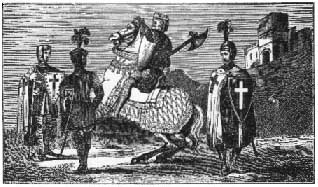 Much has been written about the Templars, their secrets, their history, etc. Our purpose is not to go over facts that can be better
researched in other books and publications. We shall merely point out the similarities between the Assassins and
the Templars: same purpose, same organization (Grand Master = Cheik El Dejebel; Grand Prieurs = Dais; Chevaliers
[Knights] = Refik; Ecuyers [Squires] = Fidavi; Freres servants [Brothers] = Lasik), same power, same methods and, strangely, even the same symbols: a holy emblem in
red over a white background.
Much has been written about the Templars, their secrets, their history, etc. Our purpose is not to go over facts that can be better
researched in other books and publications. We shall merely point out the similarities between the Assassins and
the Templars: same purpose, same organization (Grand Master = Cheik El Dejebel; Grand Prieurs = Dais; Chevaliers
[Knights] = Refik; Ecuyers [Squires] = Fidavi; Freres servants [Brothers] = Lasik), same power, same methods and, strangely, even the same symbols: a holy emblem in
red over a white background.
S. Ameer Ali, an Orientalist of considerable repute, goes further in his assessment: "From
the Ismailis the Crusaders borrowed the conception which led to the formation of all the secret societies, religious
and secular, of Europe. The institutions of Templars and Hospitallers; the Society of Jesus, founded by Ignatius
Loyola, composed by a body of men whose devotion to their cause can hardly be surpassed in our time; the ferocious
Dominicans, the milder Franciscans - may all be traced either to Cairo or to Alamut. The Knights Templar especially,
with their system of grand masters, grand priors and religious devotees, and their degrees of initiation, bear
the strongest analogy to the Eastern Ismailis."
2. The Fall of the Templars
The story of the fall of the Templars is also very well covered in various books on the subject. We shall highlight
only the major points here.
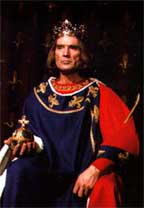 In 1306, Capetian King of France Philippe
IV (the Fair) decided to destroy the Templars. There is little doubt that
his motivation was greed -- France was virtually bankrupt at the time -- and power. He struck the following year,
arresting the Templars, and dismantling the order. The executor of his policy was the Chevalier Guillaume de Nogaret.
After an initial, mild protest from Pope Clement V, Philippe received the support of the Church, who also had accounts
to be settled with the Templars. At the Council of Vienna in 1311, the Church formally abolished the Order.
In 1306, Capetian King of France Philippe
IV (the Fair) decided to destroy the Templars. There is little doubt that
his motivation was greed -- France was virtually bankrupt at the time -- and power. He struck the following year,
arresting the Templars, and dismantling the order. The executor of his policy was the Chevalier Guillaume de Nogaret.
After an initial, mild protest from Pope Clement V, Philippe received the support of the Church, who also had accounts
to be settled with the Templars. At the Council of Vienna in 1311, the Church formally abolished the Order.
On 18 March 1314, Grand Master Jacques de Molay -- grand master of the "Outer Temple" as opposed to the
"Inner Temple" -- was burned at the stake. His dying words were: "Pope
Clement, Chevalier Guillaume de Nogaret, King Philippe, before a year, I am ordering you to appear before the tribunal
of God. Cursed you will all be! Cursed until the 13th generation!"
Writer Maurice Druon (of the French Academy) in his six-volume series, Les
Rois Maudits (The Accursed Kings) shows in great details how Jacques de Molay's curse came to pass, in every detail, and how
it eventually triggered the end of the Capetian dysnasty, and the Hundred Years War between England and France.
Do we need to state here that every serious historian believe that the Temple survived its destruction? In Portugal,
it merely changed it name to "Knights of Christ". In Germany, it merged with the Teutonic Knights.
It is a well-established fact that all of the French Temple's archives and treasures vanished overnight, and Nogaret's
men found nothing of value in their thorough searches throughout the country. Templar Jean de Chalon testified
under torture at his trial that, having anticipated the King's dastardly plan, the Inner Order had ordered all
of the Temple's goods and treasures packed in a chariot caravan, which was seen travelling west of Paris, under
the leadership of Hugues de Chalon and Gerard de Villers, presumably to beceventually loaded into eighteen waiting
ships.
There has been many hypotheses written about the final destination of the treasures of the Templars, some even
pointing to the New World! But it is far more likely that the quickest, shortest and safest destination was --
England. The English King was a staunch ally of the Templars -- he was the only one who stuck with his protests
-- and besides, such a scheme had already worked once before in 1247. One might add that Arsene Lupin later explained how the use of the secret
underground river and the hidden fortress of the Hollow Needle may have helped made such a scheme feasible (The Hollow Needle).
The links between the Templars -- who greatly supported and, some say, inspired the builders of the Cathedrals
-- and what became known as the Free Masonry, are also too well known to be recounted here in detail. For example,
in 1155, Bertrand de Blanquefort, a Grand Master of the Templars, was elected Grand Master of the Emglish Masons.
The formation of the the Illuminati by Freemasons and the instigation of the French Revolution and anti-papacy
movements in the eighteen century have been seen by many as a fulfilment of Templar revenge. "Thus the Order of Knights of the Temple was at its very origin devoted to the cause of opposition
to the tiara of Rome and the crowns of Kings, and the Apostolate of Kabalistic Gnosticism was vested in its chiefs.
(...) Hence Free-Masonry, vulgarly imagined to have begun with the Dionysian Architects or the German Stone-workers,
adopted Saint John the Evangelist as one of its patrons, associating with him, in order not to arouse the suspicions
of Rome, Saint John the Baptist [the Johannite heresy], and thus covertly, proclaiming itself the child of the
Kabbalah and Essenism together." Allocution of Pio Nono against the Free
Masons.
In conclusion, there can be little doubt that:
1) After their official "destruction," the Templars merely went underground and "reincarnated"
themselves in the guise of various masonic and other secret societies;
2) More than ever, their goal was to destroy the Monarchs. In fact, a popular legend states that, when Louis XVI
was guillotined, a man stood among the crowd and shouted: "Jacques de Molay, you are avenged!"
3. THE CONSPIRACY
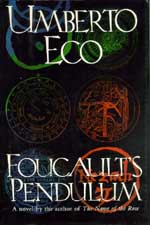 The best and most comprehensive account of what happened after the Templars went underground
remains Umbert Eco's erudite Foucault's Pendulum, required reading for anyone wishing to pursue this investigation in greater depth. Robert
Shea and Robert Anton Wilson's Illuminatus Trilogy
is also recommended.
The best and most comprehensive account of what happened after the Templars went underground
remains Umbert Eco's erudite Foucault's Pendulum, required reading for anyone wishing to pursue this investigation in greater depth. Robert
Shea and Robert Anton Wilson's Illuminatus Trilogy
is also recommended.
Still, the purpose of this article is not to delve into the Templars' occult history, their connection to the Holy
Grail, Alchemy, notorious adepts such as Nicolas Flamel (1330-1418) and Paracelsius (1493-1541), The Rosicrucians,
and many other related topics. Our purpose is to limit ourselve to one small fraction of this vast occult history,
that which connects with the Wold Newton phenomenon. However it is worthwhile to keep in mind that no one can truly
understand what happened at Wold Newton without having a grasp of the larger picture...
Seeking for clues, it is worth remembering the duality we previously noted in the Templars' nature. On the one
hand, we have a society whose purpose is to fight for justice, freedom, equality, and against evil and tyranny
-- all noble goals. On the other hand, the same society thrives on secret power, accumnulates wealth, does not
hesitate to use force, and believes that the ends always justifies the means.
It is a short step from Robin Hood to Turpin, from Arsene
Lupin to Fantômas. Throughout the history of what we will now refer to merely as the "Conspiracy",
we see the same pattern occur again and again: noble intentions perverted, good men becoming power-mad or evil.
The apple does not fall far from the tree... Such was also the fate of two of the Conspiracy's most notorious social
experiments: the French Revolution and
Napoleon. But again, we anticipate...
 Thanks to the detailed research of Alexandre Dumas and his collaborator, Maquet, it has
been estblished, for example, that Joseph Balsamo, a.k.a. Cagliostrio (among other identities), was a member of
several secret and masonic societies that conspired against various Monarchies during the 1700s. His actions, chronicled
in Joseph Balsamo and Le Collier de la Reine, eventually gave rise to both the
American and the French Revolutions.
Thanks to the detailed research of Alexandre Dumas and his collaborator, Maquet, it has
been estblished, for example, that Joseph Balsamo, a.k.a. Cagliostrio (among other identities), was a member of
several secret and masonic societies that conspired against various Monarchies during the 1700s. His actions, chronicled
in Joseph Balsamo and Le Collier de la Reine, eventually gave rise to both the
American and the French Revolutions.
(The story of Joseph Balsamo is told in
our companion article, Who Was Nobody?)
But Balsamo enters our story only in the 18th century. To better understand the chain of events that led to Wold
Newton, we must first cast our eyes further back, and consider the mysterious figure of one Andrea Vitelli, Count
of Monteleone.
4. THE FIRST GODFATHER (1)
We are lucky that the complex life of this fascinating historical figure has been chronicled by writer Paul Féval,
who devoted most of his life, and a dozen of volumes, to this prodigious saga.
In Bel Demonio, which chronicles events
taking place between 1625 and 1655 in Sicily in the region of Monteleone, Paul Feval tells us how François
Vitelli, heir to the title of Count of Monteleone, was murdered by his jealous cousin Ercole Vitelli, under the
very eyes of his son Andrea.
Andrea managed to escape, and returned ten years later, now calling himself Bel Demonio (Beautiful
Demon), and being the leader of a gang of bandits known as the Camorra. Feval tells us that Andrea Vitelli was also connected
with (possibly founded) the religious order of the Frères de la Merci (Brotherhood
of Mercy), a dark and mysterious sect, particularly present in the Kingdom
of Naples, Sicily, Sardinia and Corsica. It is the Brothers of Mercy who later educated and trained Joseph Balsamo
at their convent of Caltagirone in Sicily. One also remembers that the pendant worn by Colonel Bozzo-Corona of
the Black Coats is called the Scapulary of Mercy...
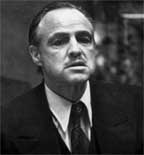 After getting his revenge, and reclaiming his rightful title, Andrea of Monteleone
went on to become a powerful Sicilian nobleman and, undoubtedly, a leader in the local proto-Mafia organization
which some historical documents trace to the Sicilian rebellion of 1282 known as the Sicilian Vespers. One may
in fact speculate that the fictional town of Corleone created by Mario Puzzo in his notorious novel The Godfather is nothing more than a transparent
disguise for Monteleone, and that Don Vito Corleone is, in fact, a descendent of Bel Demonio...
After getting his revenge, and reclaiming his rightful title, Andrea of Monteleone
went on to become a powerful Sicilian nobleman and, undoubtedly, a leader in the local proto-Mafia organization
which some historical documents trace to the Sicilian rebellion of 1282 known as the Sicilian Vespers. One may
in fact speculate that the fictional town of Corleone created by Mario Puzzo in his notorious novel The Godfather is nothing more than a transparent
disguise for Monteleone, and that Don Vito Corleone is, in fact, a descendent of Bel Demonio...
Andrea Vitelli's activities between 1655 and 1800 have not been chronicled, at last not by Féval. However,
in Les Habits Noirs,
Féval chronicled in great detail the life of the man known as the Colonel, or Colonel Bozzo-Corona, a.k.a.
Michele Bozzo, Fra Diavolo, Bel Demonio, the Godfather, and many other aliases. Allegedly born between 1722 and
1739, allegedly killed in 1841 (even though he reappeared as late as 1853!), this man was also connected to the
Mario de Monteleone who, in 1808, founded the secret society of the Companions of Silence (also known as the Iron
Knights) in Naples. Some claims he was Mario's father. Maybe Mario was but one of his many aliases? Was he a descendent
of Andrea Vitelli, the first Bel Demonio? Or could he possibly have been Andrea himself -- almost 200 years old?
Had Andrea become one of the Nine, like the Old Man of the Mountain, Flamel and others before him? The truth will
likely never be known... For the purposes of this article, we shall refer to this man simply as the Colonel, and
whether or not he was Michele Bozzo, Mario de Monteleone, Andrea Vitelli, Bel Demonio, Fra Diavolo or any other
is ultimately a matter for the reader to decide... (For
more about the man known as the Colonel, click here.)
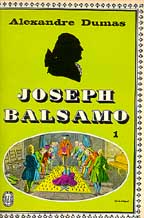 Joseph Balsamo's activities, on the other hand, were well chronicled by Alexandre Dumas,
and others, and we already have established the connection between him and the Brotyers of Mercy. We know that
secret meetings and conclaves were held throughout Europe -- Joseph
Balsamo opens with the description of such a conclave, which ends with the
renewed vow to destroy the Monarchs. When Balsamo-as-Cagliostrio was briefly imprisoned in Paris in the Bastille
after the affair of the Queen's Necklace, historical documents tell us that he was found in possession of a simple
sheet of paper found in a safe with the letters -- L. P. D. on it. Lilia Pedibus Destruc.
Latin for Let's Trample the Lily -- the
fleur-de-lys being the emblem of the Monarchy.
Joseph Balsamo's activities, on the other hand, were well chronicled by Alexandre Dumas,
and others, and we already have established the connection between him and the Brotyers of Mercy. We know that
secret meetings and conclaves were held throughout Europe -- Joseph
Balsamo opens with the description of such a conclave, which ends with the
renewed vow to destroy the Monarchs. When Balsamo-as-Cagliostrio was briefly imprisoned in Paris in the Bastille
after the affair of the Queen's Necklace, historical documents tell us that he was found in possession of a simple
sheet of paper found in a safe with the letters -- L. P. D. on it. Lilia Pedibus Destruc.
Latin for Let's Trample the Lily -- the
fleur-de-lys being the emblem of the Monarchy.
Readers will refer to our companion article, Who Was Nobody?, which mentions meetings held with Adam Weisshaupt of the Illuminati in Ingolstadt, with Casanova
in Venice, Thomas Paine, and others. Again, the purpose of this article is not to delve too deeply into the Occult
History of Europe, but simply to make the point that secret societies were the manipulating force behind events
that led to the French Revolution. That is not to say that, had there been no Conspiracy, there would have been
no Revolutions -- just that the revolutionary cause was greatly helped by the secret societies. And that all this
can be traced back to the Templars, and the Assassins.
No one will argue that the French Revolution was not a social experiment that went horribly wrong. While the ideals
of freedom and equality at first endeared it to many, the bloody massacres of the Reign of Terror tarnished its
image forever. Brave men, who otherwise might have sympathized with its goals, stood up and fought to save its
victims -- the Chevalier de Maison-Rouge and the Scarlet Pimpernel come to mind.
Still, when an experiment goes wrong, one must try to correct it. And this simple truth brings us to Wold Newton,
in 1795.
5. THE TRUTH BEHIND WOLD NEWTON
Thanks to Philip Jose Farmer's diligent research, and the further contributing works of the New Wold Newton Meteoritic
Society, we know that the following people were travelling together near Wold Newton in Yorkshire on December 13,
1795:
-- John Clayton, third Duke of Greystoke, and his wife, Alicia Rutherford;
-- The eleventh Baron Tennington and his wife, Elizabeth Cavendish;
-- Honore Delagardie, and his wife, Philippa Drummond;
-- Fitzwilliam Darcy, and his wife, Elizabeth Bennett;
-- Sir Percy Blakeney, and his (second) wife, Alice Clarke Raffles;
-- Baronet Hugh Drummond (his wife, Georgia Dewhurst, was likely not present);
-- Dr. Siger Holmes and his wife, Violet Clarke.
Also present were four coachmen, Louis Lupin, Albert Lecoq, Arthur Blake and (as theorized by some), Simon MacNichols.
It is also assumed by some that a friend of Dr. Holmes, Sebastian Noel, was following on horseback.
What no one seems to have asked is -- why were these people there in the first
place?
There is no journey without a purpose, and therefore it is logical to assume that there must have been a purpose
for this journey, at least for some members of this company.
Our task is to determine the purpose of this journey.
First, what do we know?
-- Thanks to the works of Alexandre Dumas and Paul Féval, as well as some back-up historical evidence, we
know that both the Colonel and Joseph Balsamo (Cagliostro) were in England in 1795.
-- Thanks again to the works of Paul Feval, we know that the mysterious Lecoq was a "Master of the First Degree"
or a member of the High Council of the Colonel's secret society known as the Veste Nere, the Black Coats, and --
more importantly! -- the Rozenkreuz (Rosicrucians!) in Germany! One will note the similarities with freemasonry.
One will also ponder the fact that "Lecoq" means "The Rooster," one of the symbols of the French
Revolution, and one will remember that, for secret societies, names are nothing more than convenient symbols and
covers. (More about the Lecoq family.)
At this point, we might as well put forward our first hypothesis:
The reason for the fateful journey of December 13, 1795, was to hold a secret
meeting at Wold Newton, and the purpose of that meeting was, in simple terms, to decide how to affect the course
of the French Revolution.
We have seen how, since the Templars' times, England was a haven for secret societies and their masters... Isaac
Newton, John Dee, Edward Kelly, Alexander Sethon, the mysterious Eyrenee Philalethe, were all notorious English
adepts. Balsamo, Andrea de Felipone, Pasquale Paoli (see below), and many others, found refuge in England when
they encountered trouble on the continent. The notion of a secret conclave held in England in 1795 rather than
on the war-torn continent is therefore highly believable.
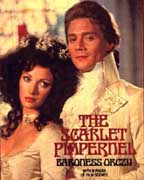 In addition to Lecoq, and Lupin (whom we shall discuss below), another person
on the list above had numerous reasons to care about France -- Sir
Percy Blakeney, who had fought the excesses of the French Revolution as the
Scarlet Pimpernel. In fact, a British and emigre force had just landed in Britanny on June 27, 1795, but trounced
on July 16. Blakeney may well have been involved in this enterprise, and the issue would have therefore figured
prominently in his mind. For all we know, this may have been the last straw, and Blakeney may have in fact called
the meeting...
In addition to Lecoq, and Lupin (whom we shall discuss below), another person
on the list above had numerous reasons to care about France -- Sir
Percy Blakeney, who had fought the excesses of the French Revolution as the
Scarlet Pimpernel. In fact, a British and emigre force had just landed in Britanny on June 27, 1795, but trounced
on July 16. Blakeney may well have been involved in this enterprise, and the issue would have therefore figured
prominently in his mind. For all we know, this may have been the last straw, and Blakeney may have in fact called
the meeting...
We believe that the secret conclave of Wold Newton brought together Sir Percy Blakeney, the Colonel, Joseph Balsamo,
Albert Lecoq and Louis Lupin to discuss what to do about France...
It is possible that others, among those listed above, were also part of the Conspiracy. Honoré Delagardie
perhaps? This is an issue that we will leave for others to speculate on.
It is also possible that there were other attendees, that have not been recorded so far. Germany would have likely
been represented. In our articles, we normally refuse to speculate without at least a shred of evidence, or some
basis for speculation. We do not make up facts just to bolster our theories. Here, however, we shall make an exception,
and state that the following paragraph is pure speculation, pending further evidence.
Based on subsequent parentage, we feel that other, so far unrecorded, attendees of the Wold Newton Conclave may
have included:
-- a member of the Gerolstein family from Germany, probably the father to Duke Rodolphe; featured by Eugene Sue
in Les Mystères de Paris.
-- a member of the Illuminati, very likely from the Kramm family, the ancestor of the notorious Cornelius Kramm whose life was chronicled by Gustave
Lerouge in Le Mystérieux Docteur Cornelius;
-- another high-ranking member of what eventually became British Intelligence, William de Winter, the grand-son
of a man called Mordaunt, the bastard son of Lord de Winter's brother amd the woman known as "Milady"
(the full story of the de Winters is narrated by Alexandre Dumas in Vingt Ans
Apres). This man was connected to the Richmonds and the Belthams, whose descendents
appeared in biographies by Dumas and Allain & Souvestre.
-- finally, I think it is likely, considering the extensive connections between freemasons and the American Revolution,
that the Conclave would have been attended by an American. I would nominate a member of the Kent family (ex Charbonneau),
whose story was told by John Jakes.
We will note that Blakeney, the Colonel, Balsamo, Lecoq, Lupin, Gerolstein, Kramm, de Winter and Kent make the
number Nine. These would be the Nine Masters who were to decide the fate of Europe.
While the list of participants above needs further research, and may well be amended as a result, it is enough
for the purpose of this article to know that there was, in all likelihood, such a meeting, and that it involved
at least the first five persons we named above.
6. WHAT WAS DECIDED AT WOLD NEWTON
In order to further prove our theory regarding the conclave held at Wold Newton, we should also show that a decision
was reached there, and that it resulted in tangible, verifiable action.
Certainly, Balsamo's eventual departure for the United States, and his later journey to the Antarctic where he
found the secrets of a long-lost civilization, may have been planned at Wold Newton. (See Who Was Nobody?)
But we think it is even more likely that the Wold Newton Conclave would have decided to put an end to the French
Revolution. And what did effectively finish the Revolution? Napoleon.
So if we can prove that the meteoritic rise of Napoleon is a direct consequenc of the Wold Newton Conclave, and
the action of its participants, we will have built a very strong case indeed.
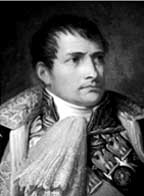 In
1795, Citoyen Buonaparte, or Sieur Napoleon, as he would have been known, was but a junior officer in the French Revolutionary armies.
Let us consider the brief chronology of his subsequent rise to power:
In
1795, Citoyen Buonaparte, or Sieur Napoleon, as he would have been known, was but a junior officer in the French Revolutionary armies.
Let us consider the brief chronology of his subsequent rise to power:
-- 1796-97: Napoleon became a national hero because of his victories in Italy, a country where the Conspracy's
control was most effective;
-- 1798: Napoleon occupied Rome and captured the Pope -- a favored target of the Conpspiracy;
-- 1799: After conquering Egypt, Napoleon had a mysterious meeting at the Great Pyramid with a man purporting to
be the Count of Saint-Germain, certainly a member of the Conspiracy -- possibly Joseph Balsamo before his emigration
to the United States. This encounter is reported by no less than the reputable French historian G. Lenotre in his
Légendes Historiques under the
title "Un Reveillon chez Cambaceres" and his attributed to Fouché, Duke of Otranto, the head of
Napoleon's secret police, who told it to a select group of people on 24 December 1814. In short, Napoleon met Saint-Germain
inside the Great Pyramid; the man of mystery outlined his great future, but warned him to not step over the boundaries
erected by his Masters.
-- On November 9, Napoleon realized his ambitions and, after a succesful coup, became First Consul.
By 1802, the French Revolutionary Wars were effectively over. Napoleon was preparing to invade England, but mysteriously
abandoned his plans. Instead, in 1804 he became Emperor, as Saint-Germain had "prophesied." But instead
of ruling France wisely -- although he did effect a number of reforms that had been on the masonic agenda -- he
broke the orders that had been given to him in Egypt and embarked upon a series of futile wars. Another of the
Conspiracy's experiments had failed -- and had to be corrected again. But this is another story...
One may well argue that even this remarkable chain of events proves no relation between Napoleon and the Conspiracy,
other than the meeting with Saint-Germain in Egypt. But what if we could establish an irrefutable connection between
the two?
Enter Louis Lupin, whose exact role until now has been carefully shrouded in mystery.
7. THE SECRET OF ARSENE LUPIN
The lupin, like the scarlet pimpernel, is a wild flower. Unlike the scarlet pimpernel, which is associated with
curing poisons and warding off against evil, the lupin is associated with wealth and power. In our article Who Was Nobody?, we have seen
the secret power of names, names like "Balsamo," "Pym," "Lecoq," etc. Could it be
that "Lupin" was such a name?...
If Louis Lupin hid a secret in his name, what was it, and what was the connection with Napoleon?
Napoleon was born in Corsica in 1769 -- 26 years before the Wold Newton Conclave. His father's family was of old
Tuscan nobility and had emigrated to Corsica in the 16th century. His father, Carlo Buonaparte, had joined the
revolutionary party led by Pasquale Paoli.
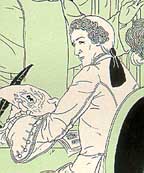 The
son of Giacinto Paoli, who led the Corsicans against Genoa from 1735, Pasquale
Paoli followed his father into exile at Naples in 1739, studying at the military
academy there and preparing to continue the fight for Corsican independence. There is no doubt that he met Monteleone
during his stay in Naples, and joined the Conspiracy.
The
son of Giacinto Paoli, who led the Corsicans against Genoa from 1735, Pasquale
Paoli followed his father into exile at Naples in 1739, studying at the military
academy there and preparing to continue the fight for Corsican independence. There is no doubt that he met Monteleone
during his stay in Naples, and joined the Conspiracy.
In 1755, Paoli returned to Corsica and, after overcoming the Genoese faction, was elected to executive power under
a constitution more democratic than any other in Europe -- years before the drafting of the American constitution,
which as we know was inspired by masonic ideals.
For the next nine years, under the principles of enlightened despotism, Paoli transformed Corsica, first by suppressing
the system of vendetta and substituting order and justice, then by encouraging mining, building up a naval fleet,
and instituting national schools and a university. At the same time he continued the war, first against Genoa and
after 1764 against Genoa's ally, France. France bought Corsica in 1768 and invaded the island and defeated the
nationalists in 1769. Paoli fled to England, received a pension from George
III, and lived in London for the next 20 years. We shall note that this coincoided
with the period during which Joseph Balsamo, having accomplished his first French mision (described in Dumas' Joseph Balsamo) was in London.
Appointed lieutenant general and military commandant during the French Revolution, Paoli returned to Corsica in
July 1790. Breaking with France in 1793, he once more led the fight for independence and, with British naval support,
expelled the French in 1794. He then offered the sovereignty of Corsica to George III, who accepted and sent Sir
Gilbert Elliot as viceroy. Elliot in turn chose not Paoli but Pozzo di Borgo as his chief adviser. Disappointed
and not wishing to cause internal strife, Paoli retired to England in 1795
(note the date!), where he received a
British government pension.
Napoleon's father was a member of Paoli's administration, but chose to submit to the French when they regained
control of the Island and eventually became a state assessor. The name "Buonaparte" means "Good
Side" or "Good Party"...
Carlo Buonaparte and his wife had eight children, who were positioned, some would say infiltrated, in various levels of the French Revolutionary power structure -- Napoleon in the army, one
of his brothers in the law, etc. By 1795, Napoleon was like a candidate who had been groomed for a higher job,
and was waiting only for the signal of his elders...
As we have stated, Napoleon would have been called Sieur Napoleon by his fellow Frenchmen. Now, let us remove the two "O" which are at the center of his name and which means NOTHING (O = zero), like the very word written inside the Scapulary of the Corsican Brothers of Mercy, worn by the Colonel on his chest. A
word symbolizing the doctrine of "Nothing is true"
which we have traced to the Assassins.
Now, let us play the anagram game:
S I E U R N A P * L E * N
A R S E N E L U P I N
This is the secret connection we have been looking for all along!
This proof that "Louis Lupin" was, in reality, the ninth child of
Carlo Buonaparte, and that Napoleon was a "Lupin"-- in fact, the
first "Arsene Lupin"
-- and vice-versa!
It is just a matter of knowing how and where to look!
We now know what was decided at the Wold Newton Conclave: to give Louis Lupin the signal to order Napoleon to move
and put an end to the French Revolution.
FOR MORE SPECULATIONS ABOUT DR. SIGER HOLMES AND THE CONSPIRACY
TO READ PART II:
THE INHERITORS